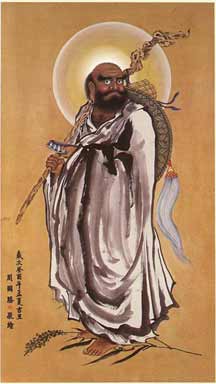LIVING AN ENRICHING LIFE NOW

Bodhidharma is honoured as the First Patriarch of the Shaolin arts
Question
Barry and I are curiously investigating the links between the teachings of Buddha, Bodhidharma, Zhang San Feng and yourself. We are interested how these teachings can be understood and used practically, in an everyday sense, and help people live a meaningful and rewarding life, here and now.
Often, when people speak about the teachings of Buddha and the sutras, the emphasis is on spiritual awakening or enlightenment. Your focus for Shaolin Wahnam is living an enriching life now. This is an extremely helpful distinction, and something that Barry and myself continue to appreciate more and more.
-- Sifu Tim Franklin, Shaolin Wahnam UK
Answer
Thank you for your implied compliments of comparing the teachings of the Buddha, Bodhidharma and Zhang San Feng, with my teaching. I really do not deserve the compliments. The Buddha, Bodhidharma and Zhang San Feng are the greatest of teachers. My teaching is really nothing compared to theirs.
One aspect, which you mentioned, is clearly distinguishable. The teachings of the Buddha, Bodhidharma and Zhang San Feng are spiritual and transcendental. My teaching is down-to-earth and phenomenal.
The Buddha, Bodhidharma and Zhang San Feng never meant to be religious. Their teachings can benefit people of any religion or of no religion.
My teaching is to use kungfu or chi kung, or both of them, to enrich our lives here and now. Kungfu and chi kung give us good health, vitality, longevity, peak performance and spiritual joys.
Question
Though Bodhidharma emphasized the need to go to the essential meaning than merely reading scriptures, he also valued scriptural knowledge. In fact, Bodhidharma held Sutras in high esteem. Particularly he held that Mahayana Lankavatara Sutra contains the essential teachings of the instantaneous realization tradition of Mahayana. When Bodhidharma made Huike his Dharma successor, along with his robe and bowl he passed on a copy of the scripture of Lankavatara Sutra.
Answer
It is well known that Bodhidharma asked his students to burn their books, forgetting the fact that he valued sutras greatly. At that time his students were focusing on the words of the sutra, so he asked them to burn their books so that they could focus on practicing what was taught in the sutras.
A sutra is a direct recording of the Buddha’s own words. Sutras of course have been translated into many languages. When a person recites a sutra, besides learning the teaching of the Buddha, he maintains the Buddha’s words, thus keeping the Buddha’s teaching alive.
It is a common misconception that a sutra teaches religion, and sings the praises of the Buddha. Far from it. A sutra addresses questions what quantum physics, the latest science, is doing now, like mind and reality.
Question
What is your understanding of the Mahayana Lankavatara Sutra and how Bodhidharma used this practically?
Answer
There are three traditions of Buddhism, namely Mahayana Buddhism, Vajrayana Buddhism and Theravada Buddhism. It is worthwhile to note that Buddhism is not a religion as most Westerners conceptualize it to be. The gist of Buddhism as taught by the Buddha is to avoid evil, do good, and cultivate the mind. Hence, a dedicated follower of any religion is actually a Buddhist.
The most important teaching of the Lankavatara Sutra is that the only reality is the mind. All phenomena, i.e. all entities we see, like people and cars, mountains and stars, are actually empty and illusory. It is indeed amazing that the Buddha taught this concept many centuries before modern science is now doing.
This concept is of utmost important in Zen, of which Bodhidharma is the founder. Bodhidharma used this concept practically in his teaching at the Shaolin Monastery. As reality is mind-only and all phenomenal things are the creation of thoughts, a Zen practitioner clears his mind of all thoughts. When he succeeds in clearing his mind of all thoughts, he attains Enlightenment.
LINKS
